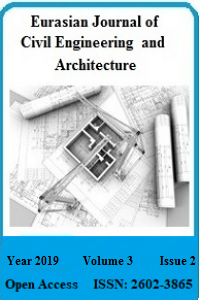Abstract
References
- Hunter RN, Self A, Read J, Hobson E. (2015). The shell bitumen handbook, ICE Publishing, London, UK.
- Kanabar, N. (2010). Comparison of ethylene terpolymer, styrene butadiene, and polyphosphoric acid type modifiers for asphalt cement, MSC thesis, Queen’s University, Kingston, Ontario, Canada
- Khatri, M.A. (2005). Selection of Mixing and Compaction Temperatures for Hot Mix Asphalt Mixtures Produced with Modified Binders PhD thesis, University of Wisconsin, Madison, USA.
- Micaelo, R., Santos, A. and Duarte, C. (2012). “Mixing and compaction temperatures of asphalt mixtures with modified bitumen.” Proc., 5 th Eurasphalt & Eurobitume Congress, Istanbul, Turkey, Vol. 7, p. 7.
- Reinke, G. “Determination of Mixing and Compaction Temperature of PG Binders Using a Steady Shear Flow Test,” presentation made to the Superpave Binder Expert Task Group, https://engineering.purdue.edu/~spave/old/Technical%20Info/Meetings/Binder%20ETG%20Sept%2003%20Las%20Vegas,%20NV/Reinke_MIX%20AND%20COMPACTINO%20INFO%20FOR%20ETG%209-15-03.pdf. September 2003.
- Sengoz, B. and Isikyakar, G. (2008). Evaluation of the properties and microstructure of SBS and EVA polymer modified bitumen. Construction and Building Materials, 22(9), pp.1897-1905.
- Vachhani, K.K. and Mishra, C. (2014). Influence of VG30 grade bitumen with and without reactive ethylene terpolymer (Elvaloy® 4170) in short term aging. Int. J. Curr. Eng. Technol, 4, pp.4206-4209.
- West, R.C., Watson, D.E., Turner, P.A. and Casola, J.R. (2010). Mixing and compaction temperatures of asphalt binders in hot-mix asphalt (No. Project 9-39).
- Yildirim, Y., Solaimanian, M. and Kennedy, T.W. (2000). Mixing and compaction temperatures for hot mix asphalt concrete (No. Report No. 1250-5). University of Texas at Austin. Center for Transportation Research.
COMPARISON BETWEEN ZERO SHEAR VISCOSITY AND STEADY SHEAR FLOW METHODS TO DETERMINE MIXING AND COMPACTION TEMPERATURES OF PMB
Abstract
In order to
obtain a better performance, different modifiers types have been adopted to
complement the rheological characteristics of the bitumen used in the asphalt
road construction. To bring the asphalt mixture to the desired workability,
bitumen and aggregate must be heated at an elevated temperature before mixing.
Thus, estimating mixing and compaction temperatures is necessary to achieve the
required performance. The equiviscous method (ASTM D 2493) has been developed
through the bitumen viscosity measurement to calculate the required mixing and
compaction temperatures. But a problem with excessive temperatures resulted
through the implementation of this method when it is applied for the modified
bitumen. Insufficiency of the equiviscous method led to a necessary need to
investigate for an alternative method which should be more applicable for the
modified bitumen. In this study, two methods named Zero Shear Viscosity (ZSV)
and Steady Shear Flow (SSF) have been examined to measure the applicability for
the modified bitumen. For this purpose, 50/70 bitumen grade was modified with
5% elastomeric type – Styrene Butadiene Styrene (SBS), and 1.5 % Reactive
Elastomeric Terpolymer type – Elvaloy (RET). The results have shown that the
application of the new alternative methods resulted in lower mixing and
compaction temperatures for the modified bitumen.
References
- Hunter RN, Self A, Read J, Hobson E. (2015). The shell bitumen handbook, ICE Publishing, London, UK.
- Kanabar, N. (2010). Comparison of ethylene terpolymer, styrene butadiene, and polyphosphoric acid type modifiers for asphalt cement, MSC thesis, Queen’s University, Kingston, Ontario, Canada
- Khatri, M.A. (2005). Selection of Mixing and Compaction Temperatures for Hot Mix Asphalt Mixtures Produced with Modified Binders PhD thesis, University of Wisconsin, Madison, USA.
- Micaelo, R., Santos, A. and Duarte, C. (2012). “Mixing and compaction temperatures of asphalt mixtures with modified bitumen.” Proc., 5 th Eurasphalt & Eurobitume Congress, Istanbul, Turkey, Vol. 7, p. 7.
- Reinke, G. “Determination of Mixing and Compaction Temperature of PG Binders Using a Steady Shear Flow Test,” presentation made to the Superpave Binder Expert Task Group, https://engineering.purdue.edu/~spave/old/Technical%20Info/Meetings/Binder%20ETG%20Sept%2003%20Las%20Vegas,%20NV/Reinke_MIX%20AND%20COMPACTINO%20INFO%20FOR%20ETG%209-15-03.pdf. September 2003.
- Sengoz, B. and Isikyakar, G. (2008). Evaluation of the properties and microstructure of SBS and EVA polymer modified bitumen. Construction and Building Materials, 22(9), pp.1897-1905.
- Vachhani, K.K. and Mishra, C. (2014). Influence of VG30 grade bitumen with and without reactive ethylene terpolymer (Elvaloy® 4170) in short term aging. Int. J. Curr. Eng. Technol, 4, pp.4206-4209.
- West, R.C., Watson, D.E., Turner, P.A. and Casola, J.R. (2010). Mixing and compaction temperatures of asphalt binders in hot-mix asphalt (No. Project 9-39).
- Yildirim, Y., Solaimanian, M. and Kennedy, T.W. (2000). Mixing and compaction temperatures for hot mix asphalt concrete (No. Report No. 1250-5). University of Texas at Austin. Center for Transportation Research.
Details
| Primary Language | English |
|---|---|
| Subjects | Civil Engineering |
| Journal Section | Articles |
| Authors | |
| Publication Date | December 1, 2019 |
| Published in Issue | Year 2019 Volume: 3 Issue: 2 |
Cite
Creative Commons License
Attribution-NonCommercial-ShareAlike 4.0 International (CC BY-NC-SA 4.0)

Creative Commons Attribution-NonCommercial-ShareAlike (CC BY-NC-SA) License lets others remix, tweak, and build upon the work non-commercially, as long as they credit the author(s) and license their new creations under the identical terms.


